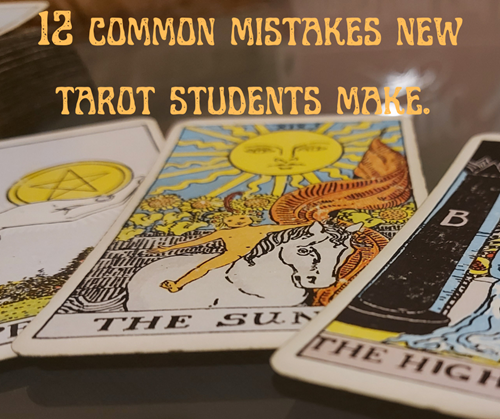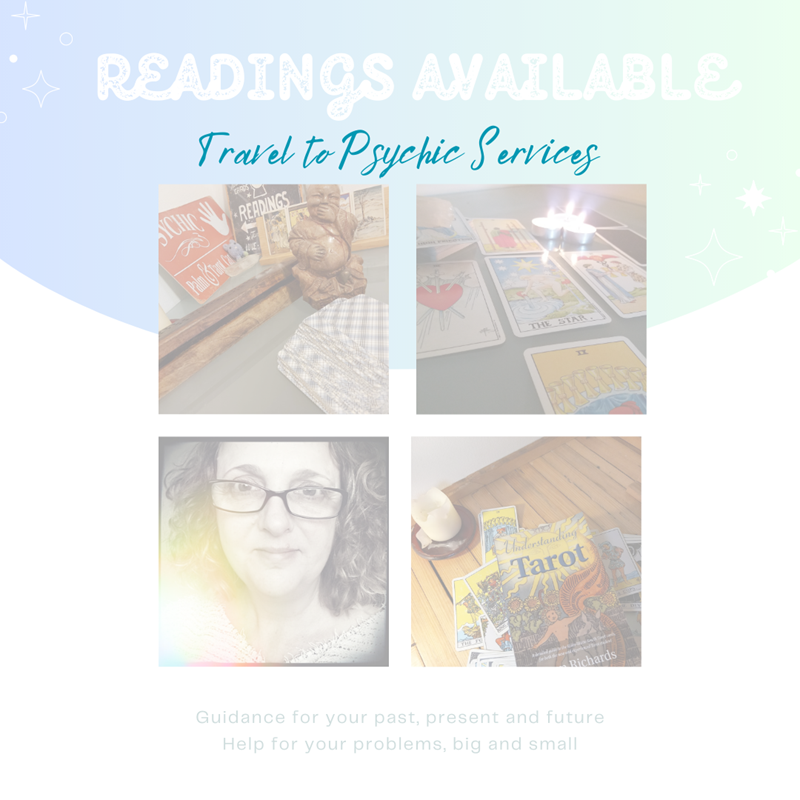
12 Common Mistakes New Tarot Students Make
Added at 07:48 on 28 October 2022
Starting to understand and learn Tarot can be a daunting task and can be filled with many potholes for those totally new to the system, as well as those who have been struggling for many years.
My book Understanding Tarot covers a lot of the issues within this blog in more detail.
1: Fancy Tarot Cards.
While we can all buy whatever Tarot deck we are attracted to, when it comes to your very first deck, buying one that is fancy and has little traditional symbolism can cause problems. One of the best Tarot decks for a new Tarot student to buy is the Rider Waite Smith deck. The main two reasons for this are that:
1: It is a very popular deck and also very well written about. So, details of what the imagery of the cards means can be found within books like mine – Understanding Tarot – and many, many others, as well as on the internet on thousands of sites for free. Resources for the deck are easy to come by and suitable for whatever your pocket allows.
2: The cards' illustrations are packed with symbolic references which your own mind will already understand to some degree. Each card tells a story and has a picture that portrays something to the reader.
The Rider Waite Smith deck is not one of the easiest, even if it is promoted as a good starter deck, because of its content. You can also get a lot of Rider'esk decks. These are decks drawn by different artists yet feature each card’s main structure image-wise. This leaves all or most of the same symbolism in place.
READ MORE Tarot Decks for Beginners
2: Not Seeing Tarot as a System
A lot of new Tarot students, as well as long-standing ones, see Tarot as a mystical item rather than a system. Seeing it as mystical or magical is not so much an issue as the lack of understanding that such things can bring. It can place emphasis on the student’s failure to develop intuitively rather than the issue of study being needed.
If you were to study Astrology or Numerology, you would not think about just sitting with numbers or a chart and hoping it would come to you. Tarot is the same. It is a system. It requires practical learning, patience, and dedication, as with any new and complex subject.
As well as an understanding of the Majors and Minor cards individually, there is also how each card relates to each other within a spread and the position it falls in, plus the questions asked. To truly understand the Tarot takes time. If you wish to be a Tarot Reader, then taking the time to see it as a system gives you more control as you then understand the importance of understanding the cards in themselves. In a way, you have 78 friendships to form, which can take decades as it is a set of relationships that constantly deepen.
3: Not Learning the Card Meanings and Psychic Expectations
I’ve seen many new, as well as intermediary tarot students, feel as if they have failed as they are simply not grasping the meanings of the cards. They have approached them with the expectation that they will bring about psychic development by simply using and looking at them.
In such cases, often what is missing is an understanding of Tarot as a system, in that there are 78 laminated cards that need to be studied.
There can be a big misunderstanding as to what their psychic self is, often seeing things through the haze of TV programmes or other fantasised views of that side of life. There is frequently the hope that simply being present with the card's development will "just happen." Psychic development, even if it is a natural element of the self that you’re aware of, takes time, dedication, and patience to bring out and be of tangible use to us.
To be a Tarot Reader, the title itself states an understanding of the subject at hand – Tarot. Psychic development can be greatly enhanced by the Tarot, yet it needs focus, not just wishful thinking, especially if it is led by superstition or negative, limiting beliefs.
They are two different subjects. To work as a psychic, you do not need to study what the Tarot cards mean; to be a Tarot Reader, you do. So, if you’re caught in this issue, maybe decide if you wish to learn the intricacies of the cards, as well as develop or just use them to springboard your psychic self. If the latter, then you can stop a lot of confusion, yet also not have the knowledge of Tarot to fall back on.
4: Trying to Learn All of the Other Systems Tarot Can Encompass.
It can be common for newcomers to Tarot to feel overwhelmed by all of the things that come attached to Tarot, such as Astrology, Numerology, Kabballah, etc. Yet, like reversed cards, when Tarot began as a game, centuries ago, none of these extra subjects were an issue.
You do not have to learn anything other than what the cards mean at the start. Unless you’re already experienced in one of the extra subjects that the deck which you're using links to, it’s OK to not give it a second thought. You do not need to become fully, or even partially, proficient in any other subject. If you wish to learn anything else and link it to your Tarot study and practice, that is a choice. Yet do not try to add the study of an equally deep subject if you’re not drawn to it, or you’re already struggling.
5: Using Reversed Cards.
A standard Tarot deck has 78 cards. If you reverse them, that is 156. If you’re new to Tarot, the upright is enough to start with, and may always be so.
Tarot was not meant to ever be read reversed. That is still relatively new in the overall history of Tarot, so avoiding reading reversed cards will not limit you in any way. Reversed cards are something you can discuss with yourself further down your Tarot development pathway. If you’re new to Tarot, my advice is to leave them be.
6: Listening to Superstition
In this new world of the internet, the fears that I see with students are far more than when I started pre-internet. Fears seem to travel faster than rational thoughts.
If anyone suggests to you that you should not do this or that in connection with Tarot, put your common-sense hat on and ask why, not as in a passing curiosity but deeply looking at why. Superstitions are often met with more fear and less rationality the deeper you dig into them.
You can buy your own decks, and nothing will happen to you if you do not "cleanse" them.
If it evokes fear, worry, or concern in you, if it makes you feel that you’re not doing it right because you're not doing this or that, question it.
7: Badly Wording Questions
Badly worded questions are a common issue with new Tarot Readers as well as new students.
Avoid double questions, such as ‘what does **** think of me and what does he want for our future’. Just ask one question.
Avoid questions with the word ‘ever’ in them, such as ‘will I ever be happy?’. Give time frames to your questions, such as ‘will I find happiness within this coming year’. ‘Ever’ is an eternity, do not think of the Tarot as a tool to look at the next 70 years of your life, but at your here and now. Time-wise – keep it local. With such questions, you may also need to define what you believe happiness to be, so be specific with your questions.
If the wording to a question is confusing, vague, or you’re just randomly throwing anything out there, then expect a confusing answer. Think about the wording of your question. Take responsibility for those things you ask about. If your question is open to interpretation, so will your reply be in a lot of cases. The answer to your question stems from within your own mind, so direct it well, so that it can be easily reflected back to you within your chosen Tarot spread.
8: Shuffling and Jumpers
I’ve seen a trend of people being told they must only take the cards from the deck that jump out.
If a lot of cards jump out then, often you’re just bad at shuffling or have slippery cards. A rare jumper card can be included in a reading, set to one side for observation. Yet, to only read those cards which jump from the deck or force their way out could take you a long time to get all the cards you need. It does not matter how you shuffle your cards or if you cut the deck or not. Traditionally, a card that jumped or worked its way out was ignored and put back into the deck, as good shuffling was aimed at not getting them at all.
They can, however, be taken as part of the guidance, the reading, so follow what is good for you, but it is not necessary.
If you do wish to only use jumper cards, then a loose and often fast shuffling method is called for.
9: Using Large Spreads – or None at all.
New students can feel compelled to go straight to the Celtic Cross, a large ten-card spread, which can be very hard to read. My advice is to, at the very start, stick to one, two, or three card spreads. I have noticed a trend for new students to just put down cards, sometimes 15 or more, or even just a few, yet have no position titles for them, so have no firm view of where each card stands within their situation.
Give any spread you use, right from the start, structure. A firm question and a spread with position titles gives you a lot more focus than just having 3 cards in front of you, which you are not sure what to attribute to what. Think before you even shuffle about what your question will be and what the positions are within the spread. Past, Present, and Future, for example.
READ MORE The Importance of Positions in Spreads
10: Using More Than One Deck
This is relatively new to me also, the use of more than one deck within a spread. I see many posts from new students who are unsure what their spread means and have used two, sometimes three different decks, one of which is an Oracle deck.
If you’re new, stick to one deck and one card per spread position. If you’re struggling to learn the Tarot, adding more than one deck to a question will simply compound that.
All you need to do a Tarot Reading is one single deck.
11: A Handful of Clarifier Cards
Traditionally, just one is needed for an entire spread in most cases, as a clarifier card is meant to give you clarity on a single card and its position, or for the overall question. If you’re new to Tarot, if the spread confuses you, adding more cards often makes it worse. I see many who will take five, six, or more cards to clarify a reading they already do not understand or clarify each card with another card that doubles the size of a spread. If the original cards confuse you, then a handful of extra cards, in most cases for the new student and reader, will add to that. Try to focus on the cards dealt before reaching for a clarifying card. If you use a spread with set titles, then this can help greatly.
12: Sideways Cards
There are some readers who use sideways cards. In my many decades, I have seen a couple. It is not for the newbie unless you know what you want a sideway card to mean, and for that, you need to understand the upright and reverse meanings. Traditionally, if a card falls sideways, either by handling or jumping, it is put the right way up, or upright.
If you do wish to incorporate sideways cards, as with reversed cards, it is not a traditional aspect of Tarot, but as there are no rules, you can add them. The first thing that you need to do, once you understand the cards both upright and reversed as mentioned, is to think about if you wish to add another two meanings to each card or just one. A card has four sides, so will you add a separate meaning for a card landing on its left and then for its right side, or just a meaning for the card on its side regardless? Unless you have someone teaching you this right from the start, this is for the advanced student and reader, especially if you're struggling to learn the Upright meanings.
Keep it simple.
All you need is a good, a standard Tarot deck, a well-worded question, some peace and quiet, and some personal honesty, added to some firm study of the subject.
Everything else is just fluff.



